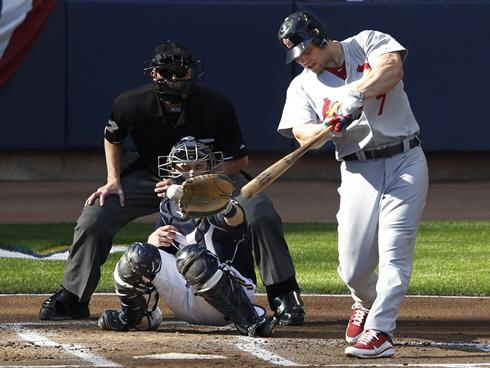Reading the ball off the bat
May 1, 2013 by Coach McCreary
Filed under Infield, Outfield
On a recent evening, I had the rare chance to watch a high school game. From where I was sitting in the stands, my viewing angle was such that I could see the batter and a particular fielder in my field of vision at all times. After a ball was hit to this fielder, something immediately jumped out at me. A couple more balls hit his way confirmed it even more. The fielder’s reactions to the ball off the bat were extremely slow. On each batted bat, the ball literally traveled 20-30 feet before the fielder even moved from his ready position on the pitch. As a defender, it will not matter how fast your footwork is if you wait until the ball is halfway to
you before you get started. Good defenders are able to react immediately after contact is made – and as you’ll see, sometimes even before that.
Two questions need to be answered here:
- What causes this slow reaction time?
- How does a fielder fix and/or improve this ability to react?
1. What causes this slow reaction time? We’ll start by assuming the player has pretty quick feet. If the player does not, there are many footwork drills to improve the quickness needed. Click HERE for a drill that can help. If the player has quick enough feet but still doesn’t get good reactions, a few things may be causing the problem. A couple things are beyond his control and a couple are not. First the factors beyond his control.
When a player plays on a different field for the first time, he may not be used to the hitting background. When a fielder looks in at home plate, the area behind the batter can make it easier or more difficult to see the ball off the bat depending on what’s there. A solid, dark background provides a good setting to see a white ball being hit. An area behind home plate that has varying shades of white or gray can be a tough background to see a batted ball come out of. When this occurs, a fielder may struggle at first until his eyes get used to the setting. This can take a game or two.
Another similar problem occurs when a player plays his first night game of the season. The different lighting conditions can have a similar effect of decreasing the defenders’ ability to see the ball off the bat. A few innings or games usually gets the player to adjust. Note: If your team plays games at night, it is to your advantage to schedule at least one practice under the lights so players get used to it prior to their games. There is an adjustment period that is needed and not all players adjust at the same rate.
There is not much a player can do to change the background and the time of the games. However, there are two things that fielders often do that hurt their ability to read the ball well off the bat. One is not watching the flight of the pitch when it approaches the batter and the second is not anticipating beforehand where the ball will be hit. And that brings us to question #2.
2. How does a fielder fix and/or improve this ability to react? The first fix is making sure players watch the flight of the pitch as it approaches the batter. Some players simply watch the batter and wait for the ball to be hit before they react. If a player watches the flight of the pitch, he can start to read where the pitch is heading and therefore can anticipate where the ball will be hit. If he does, he can learn to lean on the pitch in the direction the ball is likely to go. Here is an example. Let’s say a good hitter is up who pulls the ball very well. The catcher calls for a curveball. As a shortstop, if I watch the flight of the curveball and see it approach the batter as a “hanging curveball,” I can predict with accuracy that the batter will pull the ball. Even before the ball is hit, I can start to lean to my right slightly knowing that the ball is more likely to be hit that way. On the other hand, if a batter with a slow bat is up and I notice a

Watching the flight of the pitch or the catchers mitt can help a fielder predict where the ball will be hit.
fastball heading towards the outer half of the plate on the pitch, I can lean to my left before the ball is hit because chances are great the batter will not pull that pitch. Some players watch the actual flight of the ball and others watch the catchers glove. Movement of the glove towards a spot will also tell you where the pitch is heading. Whichever works for you.
The second fix is connected to the first one. Fielders need to be aware of who is batting, what their tendencies are, and what pitch is being thrown. Even younger kids who don’t know much about opposing hitters can make the general prediction that 3, 4, and 5 hitters tend to be pull hitters and all the others either have slower bats or use more of the entire field. Just that information alone can help a fielder anticipate where the ball will be hit.
In terms of improving in these areas, the best way by far to practice all this is to take your fielding seriously during batting practice. As a former shortstop, one of the things I would do regularly after getting my normal ground balls was to stand out at my position, watch the flight of the BP pitch, and try to correctly lean to where I thought the ball was going to be hit. The more I did it, the better I got. And so will any fielder if they take that time seriously.
When you get to each new level of the game, more players will have the same natural abilities you have. What separates the great defenders from the pack isn’t always physical skills like speed and quickness. Often it has more to do with what the fielder is doing before the ball is even hit.






Leave a Reply